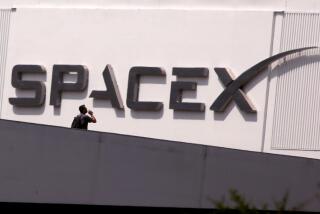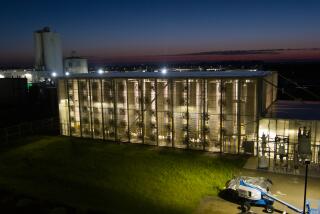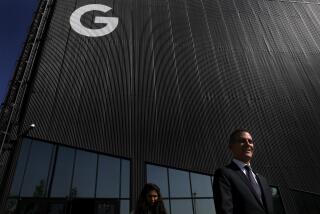A New Spark of Life for San Diego Firm’s Ultracapacitors
Hurricane-force winds swept through Mexico’s resort city of Acapulco earlier this year, leaving the water supply contaminated with potentially deadly bacteria.
It was a serious threat to the safety of the residents, but for a former Defense Department contractor in San Diego, the potential tragedy presented a golden opportunity to demonstrate the latest application of a technology that could transform everything from the cars we drive to the safety of the food we eat.
A team from Maxwell Technologies rushed to the scene with equipment that grew out of the threat of nuclear war. Maxwell is a world leader in the development of ultracapacitors, small devices that can store a prodigious amount of energy and release it in a brilliant burst lasting a few thousandths of a second.
The technology was developed to simulate a nuclear blast so scientists could test the survivability of electrical components and other hardware. But when the Cold War ended, Maxwell--like many other corporations and national laboratories--found itself all dressed up with nowhere to go.
So the company moved almost exclusively into the production of consumer goods, and that led it to Acapulco after flooding left the water supply there contaminated.
“We were able to put our equipment in there and create a vast improvement in public health for the people there,” said Ken Potashner, who joined the 33-year-old company two years ago as president and chief executive.
*
The device used in Acapulco is called PureBright, and it has been approved by the Food and Drug Administration, according to Maxwell Vice President Tom Horgan. The enclosed system can be attached to any wellhead, Horgan said, and as water flows through the chamber, ultracapacitors bombard the water about every second with a burst of ultraviolet light that is 20,000 times the intensity of the sun at sea level. None of the light leaves the system, and there is no danger to humans, he said.
“That intense burst of light destroys the DNA structures of the microorganisms, like spores, viruses or bacteria,” Horgan said. “The light alone will do that,” so no chemicals are required.
Water was purified at the rate of four gallons a minute. Health officials monitored the sickness of children in the area before and after the system was installed, and Horgan said the results were gratifying.
“They saw a dramatic reduction in terms of the number of sick children,” he said.
A similar system is now in use throughout Mexico by the “world’s largest fast-food chain,” which Maxwell officials declined to identify, as a way to protect food products from such harmful bacteria as E. coli.
The heart of the system is a tiny device that is likely to play a major role in technology in the years ahead. Some studies have identified ultracapacitors and other “pulsed power” devices as among the most important emerging technologies.
An ultracapacitor behaves somewhat like a very compact, powerful battery. But unlike a battery, which is designed to release its charge slowly, it releases all its energy suddenly, from a few milliseconds to a few seconds.
And it can be recharged just as quickly--millions of times--which would be impossible for ordinary batteries.
That capability has caught the attention of auto makers around the world: Ultracapacitors might be what is needed to allow hybrid electric vehicles to perform competitively with conventional vehicles.
Combined with a small gas turbine or diesel engine, a bank of ultracapacitors could release short bursts of energy to accelerate a car. Most of the energy needed to recharge the ultracapacitors would come from deceleration. Instead of losing that energy through heat during braking, the hybrid would convert it to electricity and recharge the devices.
*
Every auto company in the world is studying the technology, but Japan seems to have taken the lead. Both Mazda and Honda have announced plans to produce hybrids with ultracapacitors. Maxwell has a contract with Honda but won’t say if its ultracapacitors are used in the vehicle, which is supposed to get more than 70 miles per gallon.
CalStart, a nonprofit Burbank company set up to advance transportation technologies, is also involved in the research, working mainly with ultracapacitor producers SRI International in Palo Alto and Pinnacle Research Institute of nearby Los Gatos.
Other potential applications include better power sources for devices ranging from cellular phones to pacemakers. And Maxwell is working with utility giant PacifiCorp Energy Ventures of Portland, Ore., to supply ultracapacitors to factories for more reliable energy delivery.
“Right now, you can have glitches in power that will come into a plant when you start a large motor, for example,” said Gregg McKee, president of Maxwell Energy Products, a subsidiary. Ultracapacitors could bridge that gap by supplying large amounts of power the instant it is needed, McKee said.
*
As is always the case, some of these applications will prove worthwhile and some won’t. Some auto makers, for example, are leaning toward “mechanical batteries” such as flywheels to store energy created during deceleration.
But Maxwell, which found itself on the brink of oblivion amid the downsizing of the defense industry, saw its revenue climb above $100 million last year. So somebody out there is listening.
*
Lee Dye can be reached via e-mail at [email protected].
More to Read
Sign up for Essential California
The most important California stories and recommendations in your inbox every morning.
You may occasionally receive promotional content from the Los Angeles Times.










